
Toyota C-HR Review

Introduction
When the Toyota C-HR came on the scene, the target market was divided. Some hated the space-age lines and futuristic surfaces, while others thought it was the best-looking car since the Nissan Juke – a car that had a similar impact, as it happens. Whatever you think of the outside, though, there’s a serious car underneath and it has rightly received plenty of plaudits for that. With high-tech hybrid powertrains (no conventional petrol or diesel engines to see here), it still has that love-hate edge. But that only makes it more intriguing.
Select's rating score* - 3.5 / 5
At a Glance
A hybrid compact SUV that majors on style and equipment, the C-HR is tapping into the zeitgeist. The fact it handles well and won’t cost you too much to tax if you’re looking for company-funded wheels? That’s a bonus.
Every version is well equipped, with climate control, alloy wheels and a reversing camera included as standard across the range. To be honest, the basic Icon model is pretty much all the car you need, but if you want some front parking sensors and a handful of other gadgets, the mid-range Design will do the job nicely. It also gives you the option of upgrading to the more powerful of the two hybrid powertrains.
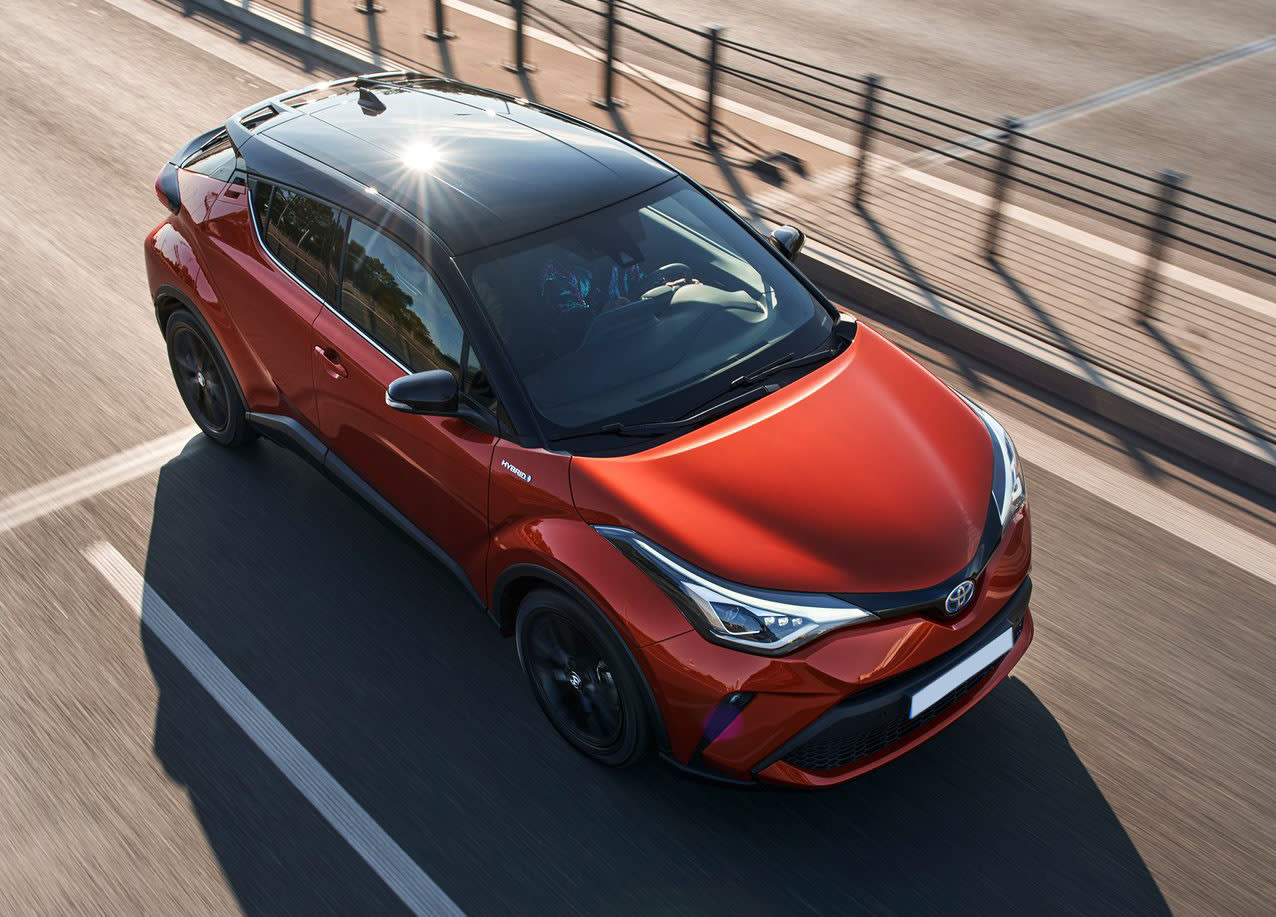
Climb higher and you’ll find the more luxurious Excel and the sporty GR Sport models, but there’s no need to bother with either unless you’re desperate to have a high-end variant.
Key Features
The C-HR is trading largely on style, and that’s what will draw prospective customers in. No, not everyone likes the spaceship look – even though it was toned down as part of a mid-life refresh – but it’s distinctive and it turns heads.
But beauty is only skin deep, so it’s a good job the C-HR delivers on more than just a superficial level. There’s a surprising amount of standard equipment on even the lowliest models, and that means you don’t have to go far up the ladder to get the car you want. Reversing cameras, LED headlights and the Apple CarPlay and Android Auto smartphone integration systems are all included across the board, and that’s becoming something of a rarity.

The hybrid powertrains have their attractions, too, including low emissions and the resulting tax breaks. They might not be particularly exciting, but Toyota has refined the concept now and the result is a marvel of engineering.
Performance & Drive
C-HR customers get to choose between two hybrid powertrains, both of which are shared with the Corolla hatchback. They’re so-called ‘self-charging’ or ‘full’ hybrids, which means they mate a petrol engine with a small battery and an electric motor that allows them to drive short distances on electric power alone. The car switches between electric and petrol modes automatically for the most efficient energy use possible, with the petrol engine and brake energy recuperation keeping the battery topped up.
That’s different to a mild hybrid, which if we were being cruel, we could describe as a glorified stop-start system. It’s also different to a plug-in hybrid, which as the name suggests, can be plugged into an electric car charger or a domestic socket to recharge the battery, often allowing the car to be used as an electric car on short journeys. When the battery runs flat, the petrol engine can take over.

Anyway, full hybrid it is, and you’ve got a choice of 1.8- or 2.0-litre units with 122hp and 184hp respectively. The latter is, as you might expect, the more sprightly of the two, with a 0-62mph time of 8.2 seconds, compared with the more pedestrian 1.8’s 11 seconds flat.
In truth, neither is especially rapid, and a 2.0-litre diesel engine will feel slightly meatier, but it won’t be anywhere near so refined. Sure, the C-HR makes a few strange noises as the hybrid system goes about its business, but it’s generally very hushed unless you really put your foot down. The reward for such an act is a painful drone that’s best avoided if possible, but if you keep your slippers on you’ll enjoy unbroken peace.
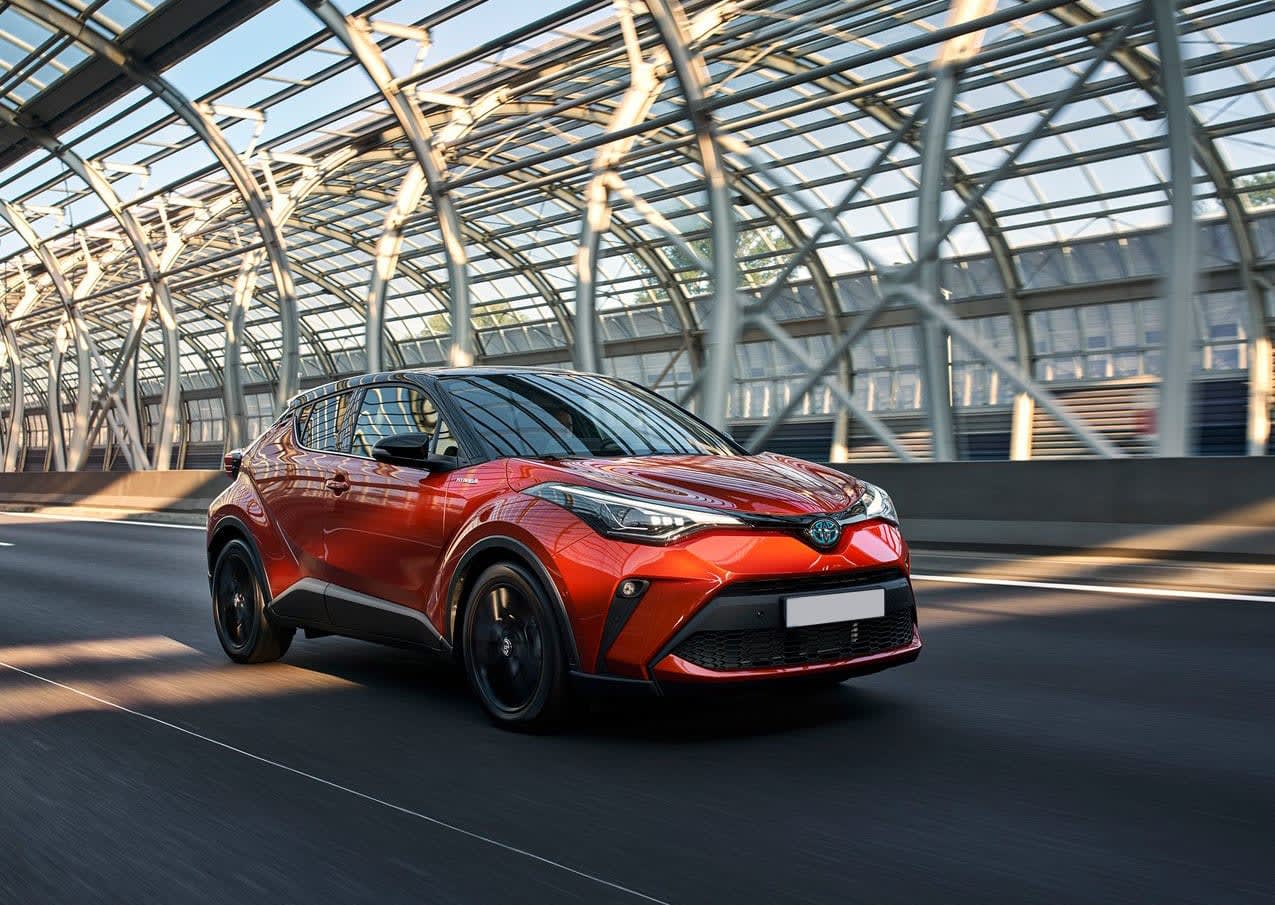
That said, the C-HR is surprisingly good to drive. The chassis is well sorted, so the body doesn’t roll around too much despite the SUV proportions, and the front end responds to your steering inputs with gusto. Toyota hasn’t built a go-faster ‘GR’ version of this car, but the C-HR underpinnings are ripe for just such a project.
Perhaps not with hybrid power on board, though, because the weight of the heavy electrical system makes its presence felt over the bumps. It isn’t bad, but you just notice the car slump into potholes more than, say, a Mazda CX-30.
Running costs
With hybrid power on board, it’s no surprise to hear you won’t be racking up big fuel bills in the C-HR. The 1.8 is the more frugal of the two versions, but both will manage more than 50mpg on the official economy test. Drive like a real saint around town, where the hybrid system comes into its own, then you could be looking at almost 60mpg from the smaller engine.
If you spend most of your time rattling up and down the M1, though, you might find an economical diesel engine better on fuel. It’ll feel punchier, too, and although it won’t be quite as quiet in the cruise, it’ll be meatier when you twitch the pedal on the right.
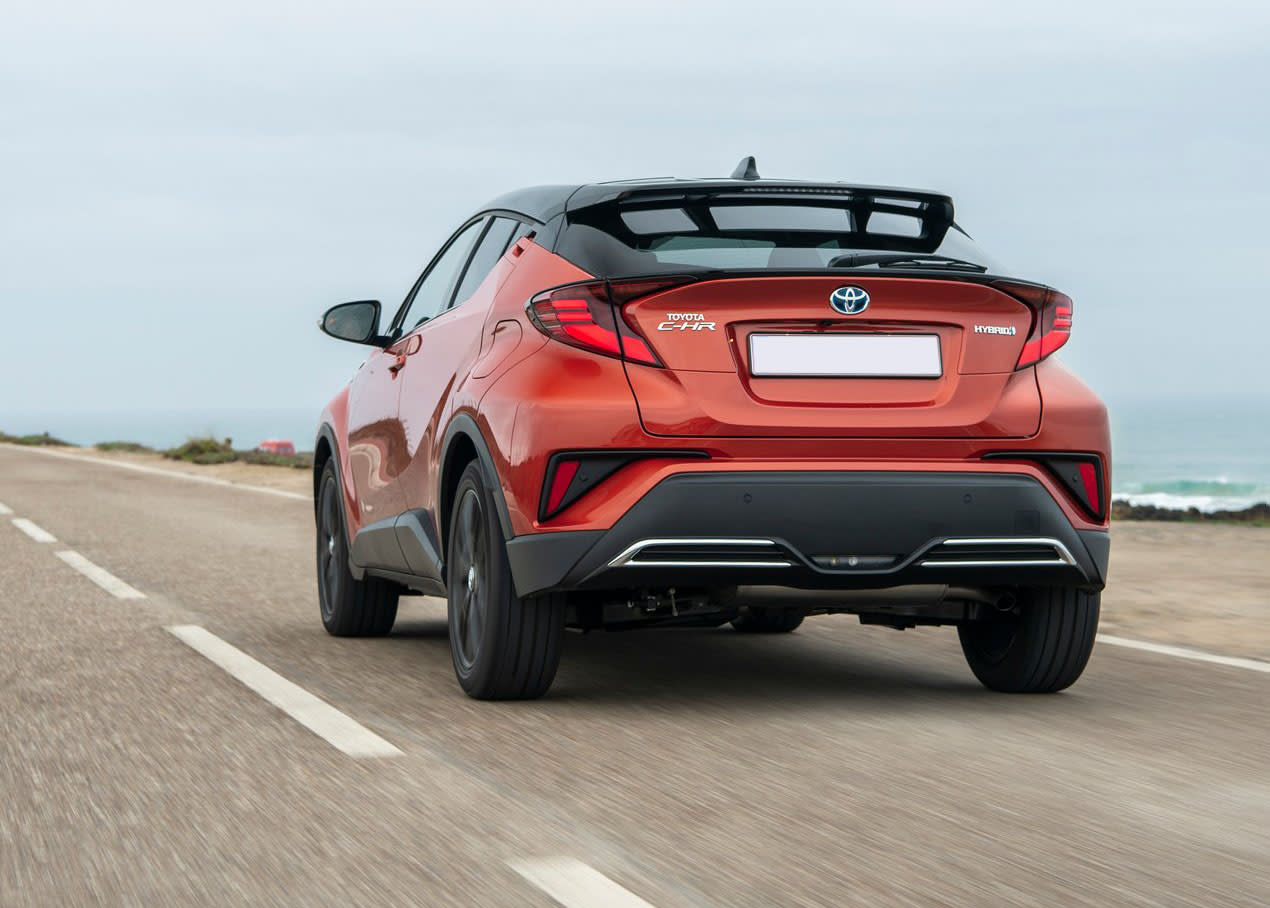
Emissions
Thanks again to the hybrid powertrains, the C-HR makes a lot of sense as a company car, with tax rates kept low by relatively low emissions. The basic 1.8-litre Icon is the most tax-efficient version, with emissions of 110g/km that keep the car in the 26% company car tax bracket for the 2021/22 tax year.
However, even the thirstiest C-HR will only emit 120g/km, putting it in the 28% tax bracket.
Interior
If you’re a fan of the C-HR’s exterior, you’ll probably like the interior too. The whole futuristic spaceship vibe is retained, with an iPad-style central screen and flowing lines. Again, some will love the design and some will hate it, but it’s generally fairly clean, without too many buttons or switches cluttering things up.
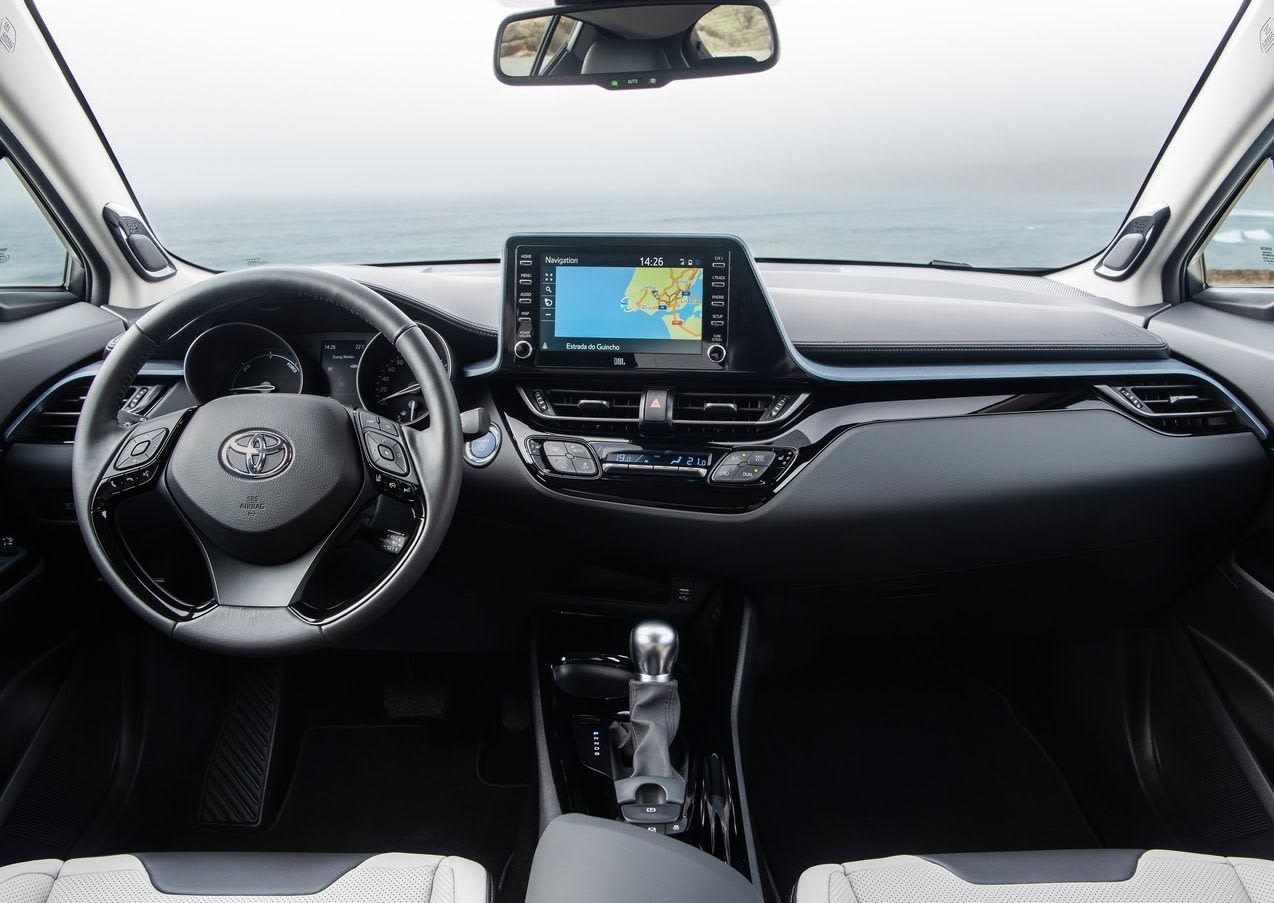
Quality is good, too, with a substantial, robust feel to pretty much everything. Sure, some of the plastics leave something to be desired, but Toyota isn’t the only manufacturer to be guilty of cost cutting here and there. Most importantly, nothing moves when it shouldn’t, and those parts that do move feel reassuringly weighty and rugged.
Technology
Unfortunately, the infotainment system doesn’t have so much going for it. The graphics look really dated by modern standards (although current-generation Hondas are just as bad) and the system isn’t very intuitive to navigate. On the plus side, most of the virtual on-screen ‘buttons’ are quite big, and that makes life easier, but the system is nowhere near as good as those of Volkswagen or Ford.
At least the Apple CarPlay and Android Auto smartphone integration systems are standard features, though, giving you a much better interface. Plug your phone in and use your own apps – it’s the best utilisation of the C-HR’s technology.

And by today’s standards, the connectivity options aren’t great either. You get a USB port for charging your phone and connecting it to the infotainment system, and you also get WiFi tech on more upmarket models. There’s even an Aux In connector, although whether you’ll find a use for that is anyone’s guess. You do at least get a reasonable sound system, and if you want to upgrade, there’s always the nine-speaker JBL-branded version, which leads the way in terms of quality.
Practicality & Boot Space
The C-HR’s design might be part of its allure, but there are catches to such a rakish rear window and a low roof line. You get plenty of space up front, but the headroom is a bit stingy in the rear and there’s a claustrophobic feeling caused by the tiny windows and the dark cabin plastics. Legroom is better, but it isn’t brilliant.
But the C-HR is aimed at younger families pootling around town, rather than those who routinely cart four six-foot adults across the country. As such, the rear space is perfectly acceptable for children, and even teenagers won’t register too many complaints unless they’re seriously tall for their age.

Further back, the boot space is largely dependent on which version you choose. Go for a 1.8 and you’ll find you have 377 litres to play with, but 2.0-litre customers have slightly less. The 19-litre difference isn’t massive, but when the C-HR’s boot is already smaller than that of a T-Roc or even a Golf, you feel a little short-changed.
Safety
The C-HR sailed to a five-star Euro NCAP crash test rating thanks in no small part to its hugely impressive adult occupant protection credentials. The European testing organisation awarded the car a 95% rating when it was tested in 2017, and although the test has evolved slightly since then, it’s still a massive achievement.
Scores for child occupant protection, pedestrian protection and driver assistance technology were admittedly solid, rather than awe-inspiring, but that’s more than enough to make the C-HR a pretty safe piece of kit.
That’s helped, of course, but the standard Toyota Safety Sense 2 technology, which is designed to help stop accidents from happening in the first place. All C-HRs come with gizmos to help you stay in your lane on the motorway and equipment that hits the brakes automatically if the car detects an impending accident. Climb up the range and you’ll add to that with gadgets such as blind-spot monitoring that alerts you to any vehicles hiding in the blind spots over your shoulders.
Options
The C-HR range is made up of three tiers, but four trim levels. That means there’s an entry-level car, a mid-range version and then two high-spec trims that take the idea of high-end in different directions.
Things kick off, then, with the Icon. But although it’s the cheapest model in the C-HR range, don’t go thinking it’s basic. You get 17-inch alloy wheels, an eight-inch touchscreen infotainment system with Apple CarPlay and Android Auto, and you get Toyota’s Safety Sense 2 driver assistance tech.
Like a cartoon Christmas list, the specification list continues with a reversing camera, two-zone climate control and adaptive cruise control that can maintain a safe distance to the vehicle in front. You get automatic LED headlights, too, and a ‘keyless’ push-button ignition system.
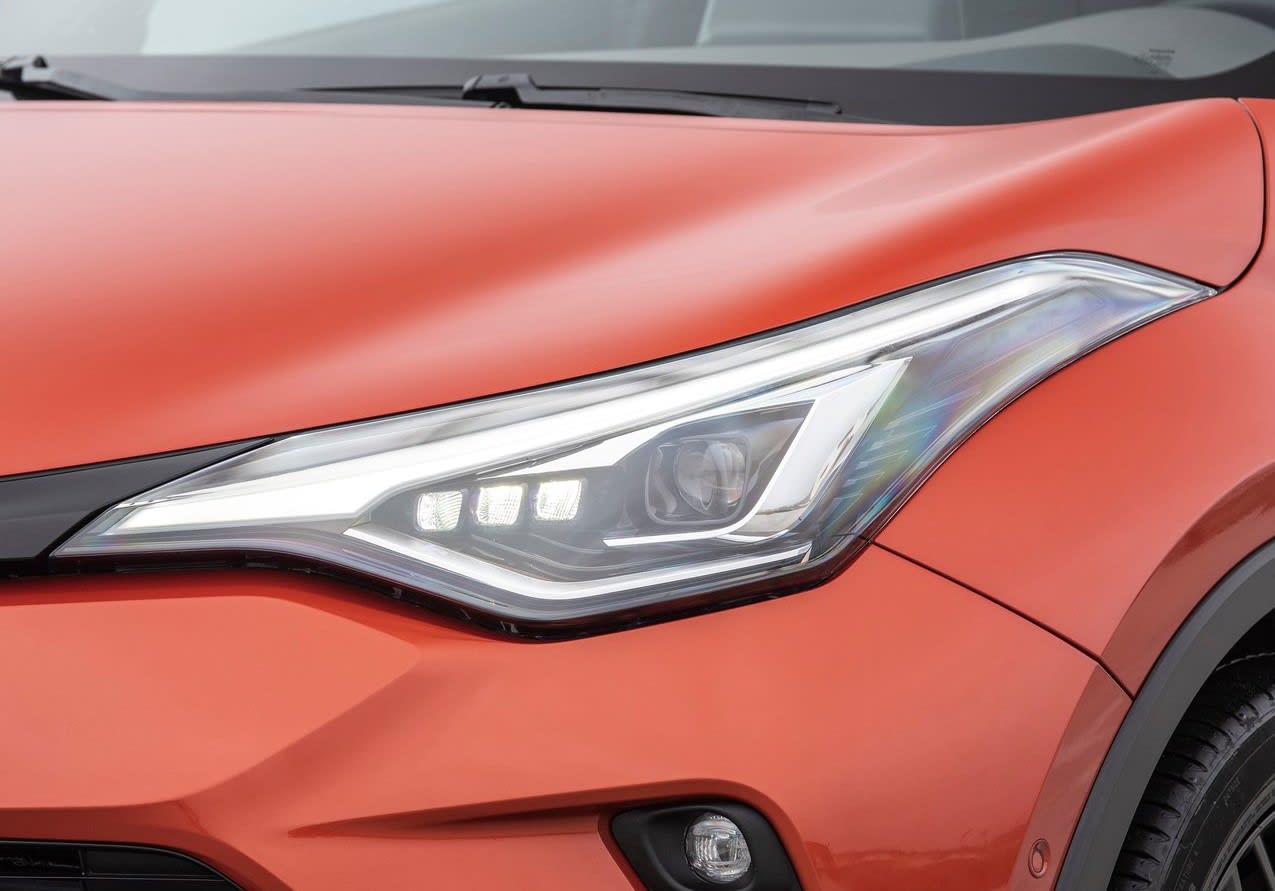
If you desperately want more equipment, the Design model is the next level up. That car gets larger 18-inch alloys and parking sensors at the front and rear, as well as satellite navigation and heated front seats. Automatic wipers also come as standard, along with keyless entry and rear privacy glass.
From thereon in, things get a little more complicated, with the Excel version marking the more natural progression from Design. That car benefits from extra safety kit, black leather and a heated steering wheel, plus some fancy lights and a few other luxurious details.
Alternatively, there’s the GR Sport version, which doesn’t improve the performance in any way, unless you count some sporty suspension, but it does give you some motorsport-inspired styling. Taking cues from the Toyota Gazoo Racing motorsport team, the car gets all the kit of the Design model, plus 19-inch alloy wheels, tinted headlights and a lot of badges. Oh, and some red stitching inside.

Options are limited, as is so often the way these days, but Toyota offers a range of packs that either add extra kit or some personalisation options. Among the most desirable additions are the JBL sound system and the black leather upholstery for Design models. Icon customers might also want to splash out on the Parking Pack or the Tech Pack, which add a few of the gadgets found further up the range.
Rival Cars
The C-HR wades into battle with some big hitters in the automotive landscape, sitting in a compact SUV sector that also puts it in the firing line of family hatchbacks such as the ever-popular Volkswagen Golf. Not only is there a wealth of cars in this class, but there’s also a wealth of talent among those cars. The C-HR has some tough competition.
For starters, SUVs such as the Skoda Karoq, Seat Ateca and Volkswagen T-Roc are all brilliant in a sort of middle-of-the-road kind of way, while the Ford Puma and Mazda CX-30 fly the flag for driving enthusiasts. Then there’s the Volvo XC40, which comes with a bit of premium flair, and the Mercedes-Benz GLA (ditto).
And this is before we look at the soon-to-be-revamped Nissan Qashqai and the Renault Kadjar with which the existing Qashqai shares so much. You could also look at an Audi Q2 or a Mini Countryman. Or a Fiat 500X if you’re after something retro. More futuristic alternatives include the forthcoming Honda HR-V and the recently launched Citroen C4,Vauxhall Mokka and Peugeot 3008 models.

If you want something that sits a little lower, the Golf is perhaps the obvious choice. Or the Seat Leon, which is essentially a Golf with a different body. Or you could have the Ford Focus, which along with the Mazda3, leads the way for the enthusiasts. Then again you could have a Vauxhall Astra – a much maligned car that doesn’t deserve the criticism – or a Honda Civic, which majors on space.
Other alternatives include the Kia Ceed and Hyundai i30, both of which are better than you might expect, or even the Skoda Scala – a surprisingly good, overgrown adaptation of the Volkswagen Polo with some sharp, Skoda-ish lines. And if you’re willing to wait a few months, there’s a new-look Peugeot 308 on the way, and that promises quite a lot.
But perhaps the most natural rival for the C-HR is the Corolla. Offering many of the same qualities with a slightly less outlandish design and a slightly lower stance, it’s a very capable family car. And if you want extra space, you can always have the estate version.
Verdict & Next Steps
At the end of the day, your feelings towards this car will probably be determined by two things: the design and the hybrid system. But there’s more to this car than just looks and technology – it drives well, too, and it’s incredibly well equipped. If you can’t stand the looks, you still wouldn’t lease one if it were the best thing on the planet. But if you do like it, you can rest assured this car is more than just a futuristic design study. It’s also a thoroughly competent urban SUV.
Where to next?
View latest Toyota C-HR leasing deals- from £245.17 per month inc VAT**
Looking for a great deal? Check out our incredible range of car lease deals
New luxury hatchback? Read our latest Car Reviews and find the right model for you
Want to know more about leasing? Take a look at our comprehensive Leasing Guides
Interested in everything motoring? Why not catch up on all the latest Car Leasing News.
*Score based on Select’s unique meta score analysis, taking into account the UK’s top five leading independent car website reviews of the Toyota C-HR
**Correct as of 14/04/2021. Based on 9 months initial payment, 5,000 miles over a 48 month lease. Initial payment equivalent to 9 monthly payments or £2206.55 Ts and Cs apply. Credit is subject to status.





















